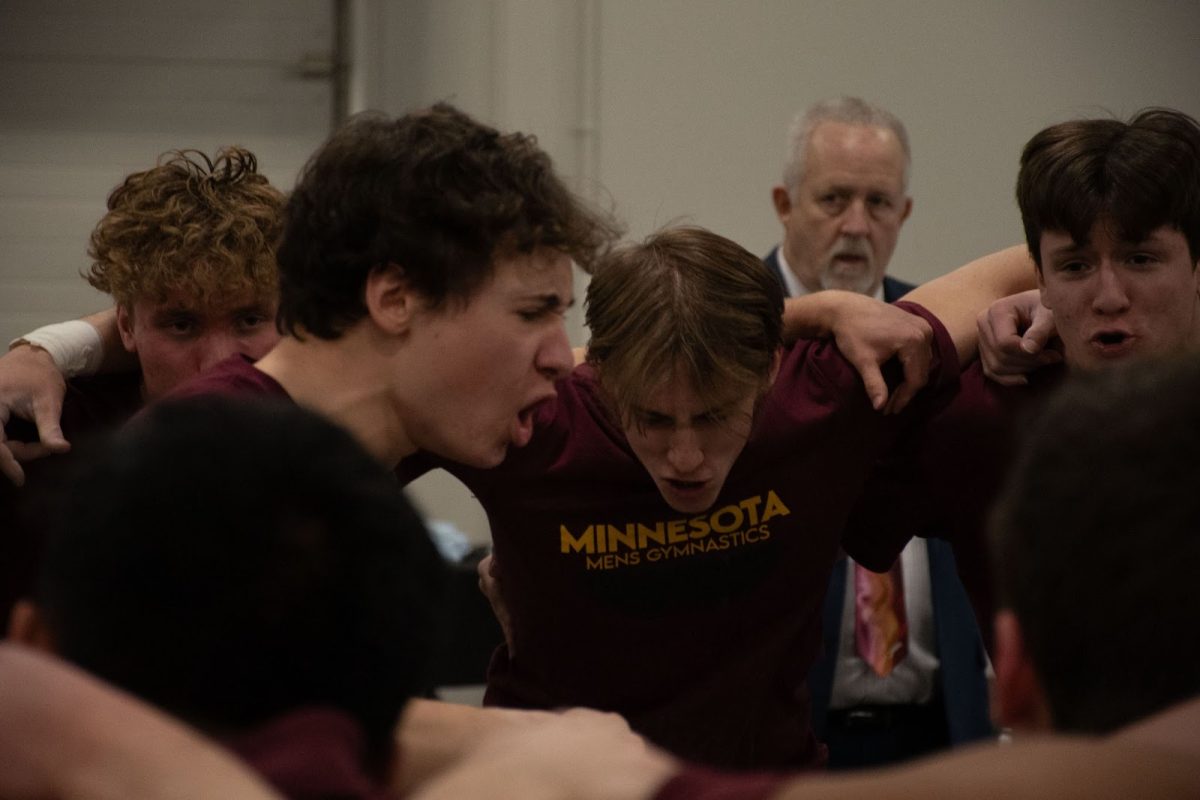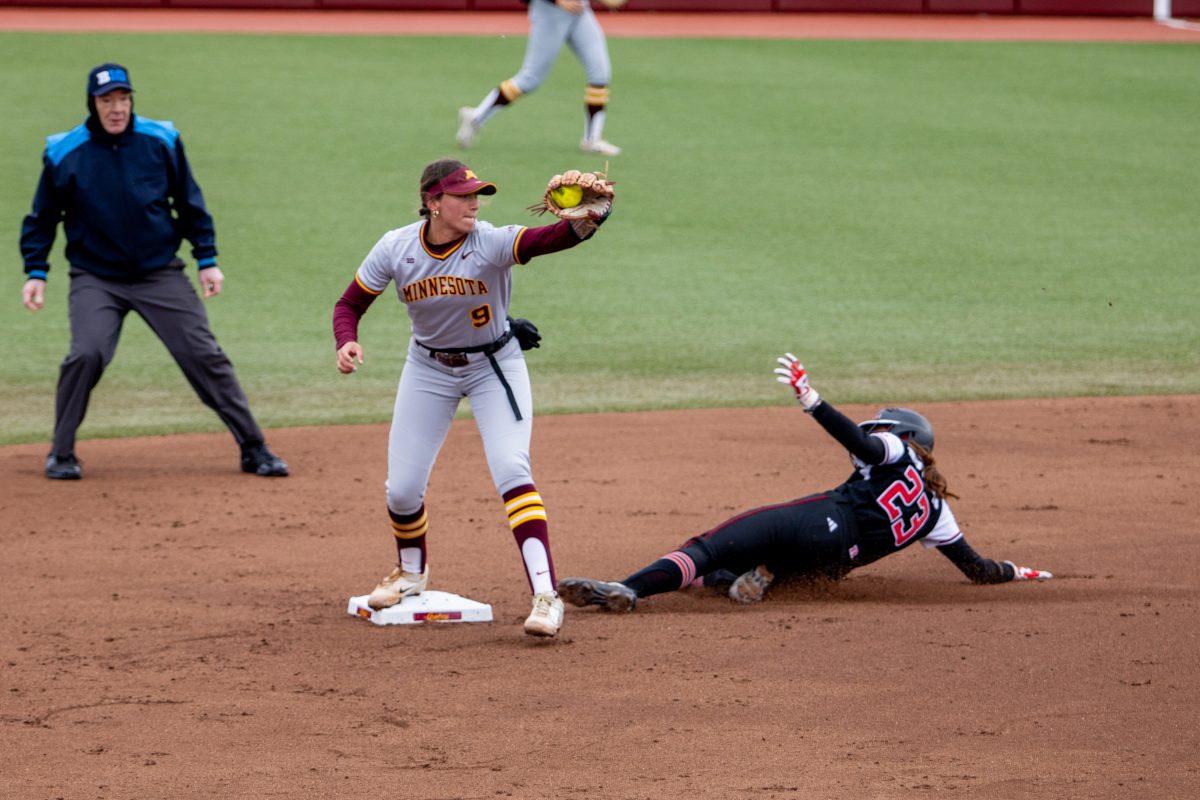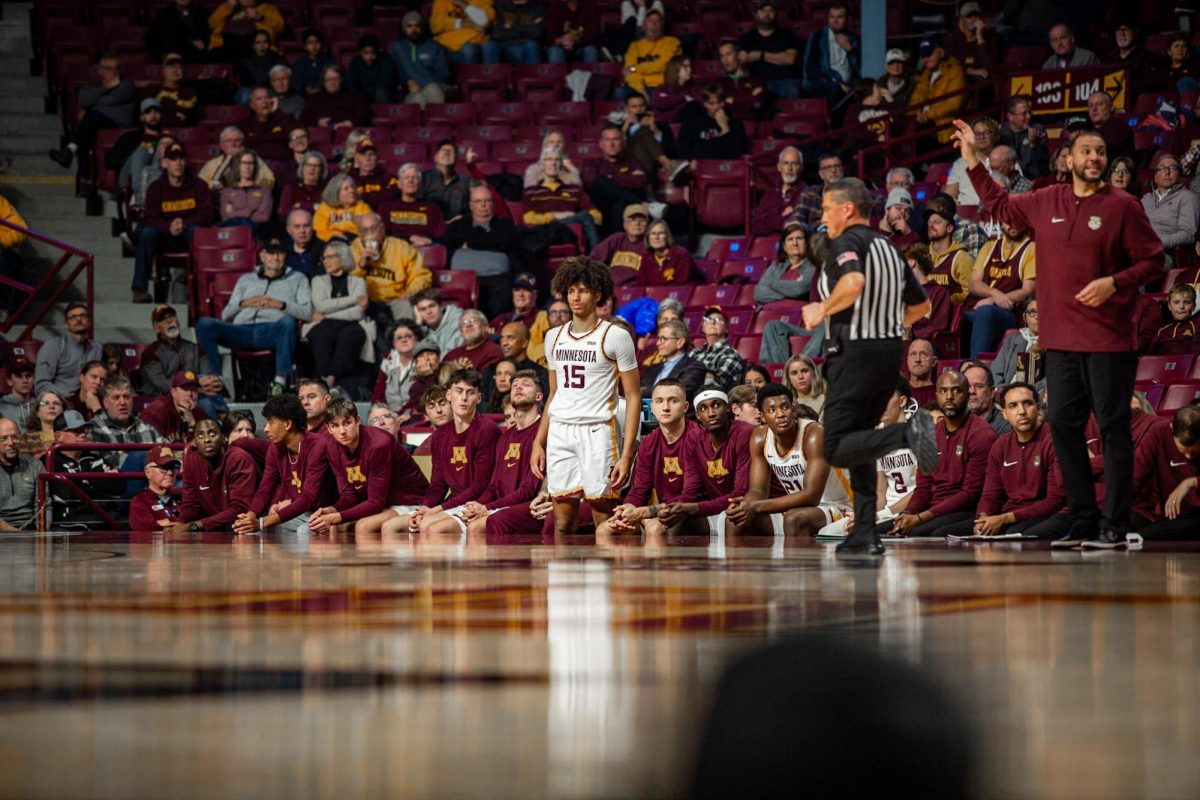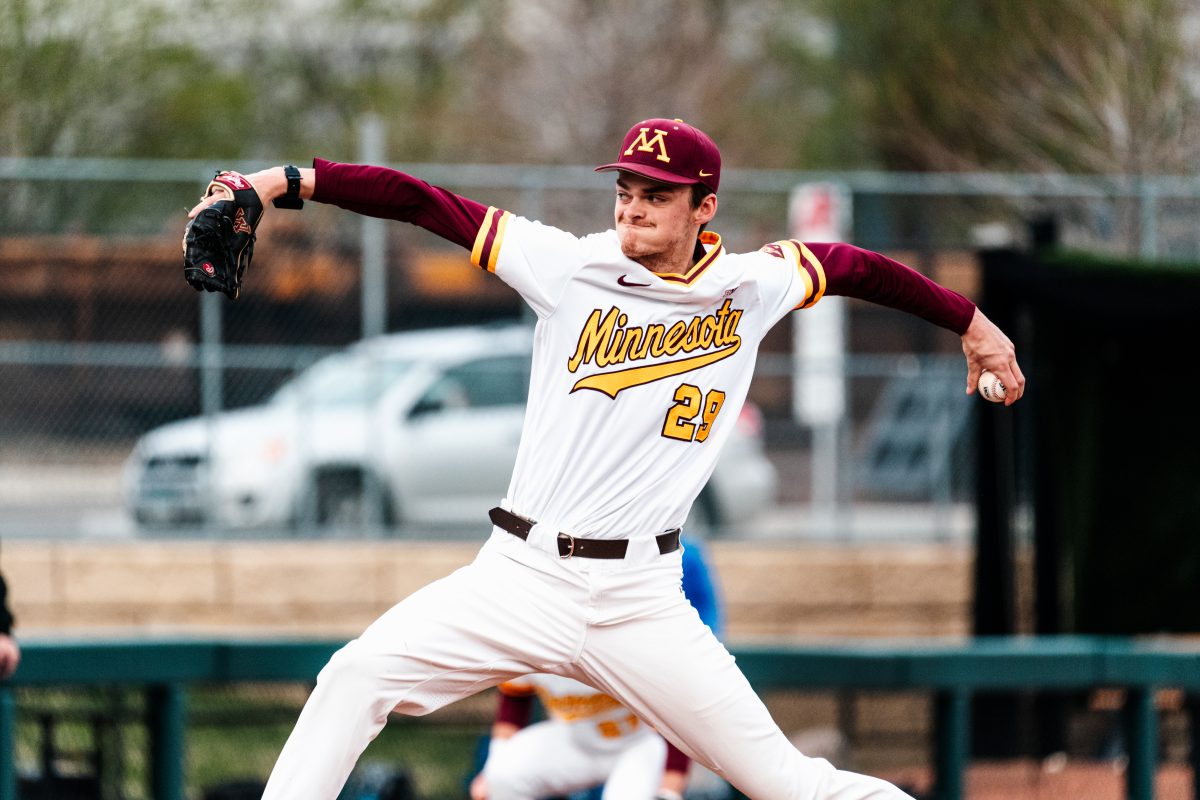In the second month of her freshman year, Titania Markland called her grandparents in tears. Like many freshmen, she was homesick.
But unlike some of Markland’s peers, her family doesn’t live in the state. Most of them are still in Jamaica, where she grew up.
Markland, a sprinter on the University of Minnesota track and field team, said during that call, her grandparents reminded her why she moved to Minnesota.
“They’re like, ‘Well, just think. You know what you want, and you got to sacrifice certain stuff for that,’” she said. “I think that’s my motivation.”
Markland, now a sophomore, is one of 41 student-athletes at the University who left their native countries to get a degree while pursuing the sport they love.
For some, the move required a leap of faith and major adjustments. They’ve had to navigate a new culture while maintaining academic and athletic focus.
But many of the University’s international student-athletes have seized the opportunity, making important contributions to their teams.
Land of opportunity
Across the Big Ten, international student-athletes make up a small portion of rosters. Minnesota is no exception, with about 6 percent of its roughly 675 athletes hailing from overseas.
The ability to play sports at a competitive level draws many international student-athletes to the United States.
Had sophomore Sara Groenewegen stayed in her native Canada, her softball career would likely be over, she said. The college league there is less competitive.
Instead, Groenewegen shined in the circle during her freshman year at Minnesota and will be the team’s ace in the upcoming season.
Junior women’s hockey goaltender Amanda Leveille, also from Canada, said she always wanted to come to the U.S. to play college hockey.
“They do have programs that offer hockey, but scholarships aren’t given,” she said, “so most Canadians come to the U.S. so they can have scholarship opportunities.”
The situation isn’t unique to Canada.
Markland left Jamaica so she could keep sprinting while pursuing meteorology.
She could have attended the University of the West Indies, but Minnesota offered her a scholarship.
Redshirt sophomore women’s basketball player Amanda Zahui B., who is from Sweden, also considered heading elsewhere. She had already played in the highest possible league in Sweden and planned on going to Spain to play professionally.
“I played three years, and we won the championship twice, so it was kind of time to leave,” she said.
Zahui B. changed her mind and chose Minnesota. Last year, she was named Big Ten Freshman of the Year.
Building bonds
The first time senior tennis player Leandro Toledo came to the U.S., he was on a recruiting trip that included a visit to Minnesota. He went to a Gophers football game, bonded with future teammates and saw the campus he would call home for four years.
But Toledo’s experience is somewhat unique. Time, distance and financial constraints make it hard for many international student-athletes to travel to prospective schools. They rely even more heavily on bonds built with coaches to help guide their decisions.
Committing to a school in another country without seeing it requires a large leap of faith, one that many of Minnesota’s international student-athletes have taken.
Markland said a few colleges overseas recruited her, but head women’s track and field coach Matt Bingle set Minnesota apart.
“He would call maybe every week, every two weeks, and see how I was [doing] … and how school was going,” she said.
Markland didn’t have a chance to visit Minnesota, but Bingle visited her twice during the recruiting process.
Time, distance and money play a factor for coaches, too. Visiting athletes and watching them compete isn’t easy when they’re thousands of miles away.
“Our sport is so number-based that if somebody runs 54 seconds for the 400 meters, they’re fast. I don’t need to see them,” Bingle said. “Whereas if you’re recruiting in football or basketball or tennis, there’s all those other intangibles that you need to record.”
In addition to writing letters to prospective international student-athletes, Bingle said social media plays a role in the recruiting process.
“Messaging kids on Facebook is a big deal. It has kind of opened up the whole world. We can connect with kids instantly,” he said.
Learning the language
Gophers head volleyball coach Hugh McCutcheon has experience moving to a new country for college athletics.
McCutcheon, a New Zealand native, moved to Utah decades ago to attend college and play volleyball at Brigham Young University.
“[I] know some of the things that they’re going to encounter and some of the changes they’re going to see,” he said, “so to be able to talk about that … I think it’s a good thing.”
But McCutcheon didn’t have to adapt to a new language, a challenge some Gophers athletes face.
Junior volleyball player Daly Santana hails from Puerto Rico, a U.S. territory. She’s not an international student, but moving to Minnesota required a big cultural adjustment — largely because of the language difference.
Santana knew enough English to communicate when she came to Minnesota, but she’s learned nearly all of her English since the move.
“[In] my high school, we took English, but we just took a class and then we spoke Spanish for the rest of the day,” she said.
Student-athletes like Santana can turn to the McNamara Academic Center for help.
The center provides resources for all student-athletes, including mentor tutors who can help with coursework.
Staff members can try to find a mentor tutor to work with an athlete in their native language, said academic counselor Chris Cords.
But because English is one of the most common second languages in the world, many international student-athletes at Minnesota began speaking it at young ages.
Freshman golfer Rúnar Arnórsson said he started learning English when he was 8 years old in Iceland.
Kids today start even younger, he said.
“We speak Icelandic, but everything is in English — TV shows, movies,” he said. “We don’t dub anything.”
He said his adjustment at Minnesota has been pretty smooth, as he was exposed to English in his home country and while traveling.
“I have to do everything in English — talk, think, study. That took some time, and I’m still getting used to it, but I’m getting better at it,” Arnórsson said.
Matic Spec, a freshman tennis player from Slovenia, said he hasn’t had trouble understanding people since arriving in the U.S. for college.
“You’re confronted with [English] in every step — TV, music, and then you have classes in school,” he said.
But that doesn’t mean Spec hasn’t had a few miscommunications along the way.
“I [once] tried to order 10 buffalo wings, and somehow I ordered twice that much,” Spec said.
Culinary changes
Aside from family and friends, many international student-athletes said they missed the food back home the most.
“If you put aside friends and family, I’m just thinking about food, and I’m thinking about bread,” said golfer Emie Peronnin, who left France for Minnesota.
Carmen Laguna, her teammate from Spain, lived in Sanford Hall during her freshman year and said her dining options were limited.
“The only thing that I could eat was burgers or hot dogs or French fries, pizza, and I was like, ‘I’m sick of this. Where is the fish? Where is the meat? I need simple stuff. I don’t want more hot dogs,’” Laguna said.
Many of the younger student-athletes now live in the 17th Avenue Residence Hall, where the food options are more varied and they say they can find healthy choices.
Peronnin said she now cooks for herself and makes foods more similar to what she ate back home.
But between classes, practices and competitions, time to cook can be scarce as a student-athlete.
The kitchen, too, can be difficult to master.
“I get tired of [the food] sometimes, so I try to make something that my mom makes, but it fails,” said Zahui B., a basketball player.
But Zahui B. also has an option for some Swedish fare just a few miles away. A teammate of hers went to Ikea last month and brought her back some Swedish chocolate.
“I was the happiest kid alive,” she said.
Other cultural shifts
Food is only one of the cultural adjustments international student-athletes face.
American mealtimes shocked Laguna.
“They were like, ‘Yeah, the dining hall for dinner is open from 5 to 7,’ and I was like, ‘That’s not dinner. What do I do at 9?’” Laguna said, recalling her freshman year.
Markland was surprised by Americans’ promptness.
“Back home, we are on time, yes, but not that on time,” she said. “So like you can be five minutes late and it won’t be a problem. Here, it’s like you have to be five minutes early.”
In Germany, Toledo said people on the street would never ask a stranger, “Hey. What’s up? How’s it going?”
And a pair of shoes that might cost $80 in the U.S. would cost about $210 in Iceland, Arnórsson said.
Though cultural adjustments vary from athlete to athlete, Minnesota winters were jarring to many.
Markland came in thinking it would be cold, but what she found was even more extreme.
“I was just thinking it was going to be cold. Simple coldness. Maybe two jackets and then you’d be fine. Maybe two [layers of] pants or something,” she said. “But then when it got in November … and I was freezing, I was like, ‘Oh my God. Why did I choose to come here?’ ”
Though people sometimes think of Canada as a frozen tundra, Groenewegen said she barely sees snow in the winter back home and that the weather in Minnesota is significantly colder.
The weather was even more of an adjustment for international student-athletes who play outdoor sports.
They often find that the time for practices and competitions in outdoor sports is cut short — or even in half — in Minnesota because of the weather.
“Minnesota from, I would say, April to September is one of the prettiest states; it’s very pretty. But in the winter, it just gets very difficult, mainly because we play [an] outside sport,” said Peronnin, a golfer.
How sports are played, too, varies by region.
Spec and women’s tennis player Tereza Brichacova, who hails from the Czech Republic, said they primarily played on clay courts back home instead of the hard ones in the U.S.
And Zahui B. described the European and U.S. styles of basketball as “two different sports.”
There’s more finesse involved in the game she played at home, she said.
Beyond the adjustment
Not all of the University’s international student-athletes come from thousands of miles away.
Minnesota currently has 15 Canadian student-athletes. And for some of them, going home could consist of a relatively short flight.
But that doesn’t mean the trip happens often.
“I can’t go home like the other girls [on my team], and that’s hard when you just want to get away from things, away from college,” said Leveille, a hockey player.
And the farther away the country, the harder it is to go home frequently or see family, so many international student-athletes seek that type of support system in their new home.
“I’m really close to my family, and I wanted to go somewhere where I felt like I was a part of a [new] family and a place where I knew that my family felt safe that I was in,” Zahui B. said.
Though the motivation to move varies from athlete to athlete, the positives seem to outweigh the negatives.
Brichacova, for example, was not supposed to end up in the U.S. She planned to go to a university in Prague, but that changed when former Gophers head coach Tyler Thomson contacted her.
Brichacova’s arrival in Minnesota was her first time in the country.
“That was a little bit scary, but I kind of came here with the [thought] in my head, ‘If I don’t like it here, I don’t have to come back after the semester, so just let me give it a shot for one semester,’” the senior said.
Three years later, she still hasn’t left.






















